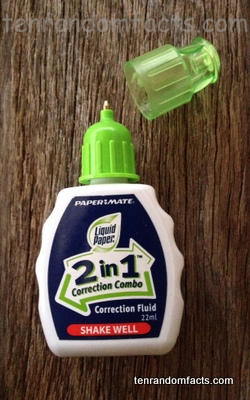Correction fluid has ensured these facts are correct.
- Correction fluid is a liquid mixture used on text surfaces like paper, to cover mistakes in text, and it can be written on after drying.
- ‘Correction fluid’ is also known as ‘liquid paper’, ‘white-out’ and ‘white away’, which are all names derived from popular fluid brands.
- Correction fluids are typically coloured white, to match the traditional colour of paper, which is white.
- Correction fluids are most often bought in bottles, and the fluid is applied by a brush or dabber, or flows through a ball point, although correction tape is also available and has the added advantage of being able to correct mistakes immediately, without having to wait for it to dry.
- Correction fluids were commonly used throughout the age of typewriters, but the fluid is less prominently used today due to the use of computers and being able to correct mistakes before printing.
- Correction fluids can be dangerous when swallowed or inhaled, due to its chemical content, which can be fatal.
- Some solvents in correction fluids may eventually escape the mixture causing the fluids to solidify, which can become reliquefied by adding a thinner.
- To prevent inhaling, some correction fluid manufacturers include foul odours in their fluids.
- Correction fluid was invented in the 1950s by the notable American secretary Bette Graham, who got the idea to use water-based tempera paint to cover mistakes, as an artist would, on typed documents.
- The first correction fluid invented was called ‘Mistake Out’, which later had a name change to ‘Liquid Paper’.





